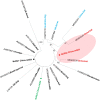Occurrence and genetic characterization of Toxoplasma gondii and Neospora caninum in slaughtered domestic rabbits in central China
- PMID: 31198175
- PMCID: PMC6568018
- DOI: 10.1051/parasite/2019035
Occurrence and genetic characterization of Toxoplasma gondii and Neospora caninum in slaughtered domestic rabbits in central China
Abstract
Currently, information on the occurrence and genetic characterization of Toxoplasma gondii and Neospora caninum in tissues of rabbits in China is lacking. In this study, brain and heart samples from 470 slaughtered domestic rabbits were collected in Henan Province, Central China. The occurrence rate of T. gondii and N. caninum DNA detected by nested PCR was 2.8% and 2.1%, respectively. There were no significant differences (p > 0.05) in the frequency of the two parasite infections in relation to sex, breed, and region. Three out of 13 T. gondii-positive samples were completely or partially genotyped at 11 genetic markers using PCR-RFLP, and one was identified as ToxoDB genotype #9. For N. caninum, three different sequences at the ITS1 region and two genotypes at the MS5 microsatellite locus were identified. To our knowledge, this is the first genetic characterization of N. caninum isolates from rabbits.
Nous manquons actuellement d’informations sur la présence et la caractérisation génétique de Toxoplasma gondii et Neospora caninum dans les tissus de lapins en Chine. Dans cette étude, des échantillons de cerveau et de cœur de 470 lapins domestiques abattus ont été recueillis dans la province du Henan, dans le centre de la Chine. Le taux de présence d’ADN de T. gondii et N. caninum, détecté par PCR imbriquée, était de 2,8 % et 2,1 %, respectivement. Il n’y avait pas de différence significative (p > 0,05) dans la fréquence des deux infections parasitaires en fonction du sexe, de la race et de la région du lapin. Trois des 13 échantillons positifs pour T. gondii ont été complètement ou partiellement génotypés au moyen de PCR-RFLP sur 11 marqueurs génétiques, et un a été identifié comme étant le génotype #9 de ToxoDB. Pour N. caninum, trois séquences différentes de la région ITS1 et deux génotypes du locus microsatellite MS5 ont été identifiés. À notre connaissance, il s’agit de la première caractérisation génétique d’isolats de N. caninum provenant de lapins.
© W. Qian et al., published by EDP Sciences, 2019.
Figures


Similar articles
-
Molecular Detection and Genotyping of Toxoplasma gondii and Neospora caninum in Slaughtered Goats in Central China.Foodborne Pathog Dis. 2020 May;17(5):348-356. doi: 10.1089/fpd.2019.2726. Epub 2020 Mar 13. Foodborne Pathog Dis. 2020. PMID: 32176538
-
Seroprevalence and molecular detection of Toxoplasma gondii and Neospora caninum in beef cattle and goats in Hunan province, China.Parasit Vectors. 2024 Apr 26;17(1):195. doi: 10.1186/s13071-024-06283-9. Parasit Vectors. 2024. PMID: 38671515 Free PMC article.
-
Molecular assessment of Neospora caninum and Toxoplasma gondii in hooded crows (Corvus cornix) in Tehran, Iran.Comp Immunol Microbiol Infect Dis. 2018 Apr;57:69-73. doi: 10.1016/j.cimid.2018.06.008. Epub 2018 Jun 14. Comp Immunol Microbiol Infect Dis. 2018. PMID: 30017081
-
Geographical distribution of Toxoplasma gondii genotypes in Asia: A link with neighboring continents.Infect Genet Evol. 2017 Sep;53:227-238. doi: 10.1016/j.meegid.2017.06.002. Epub 2017 Jun 3. Infect Genet Evol. 2017. PMID: 28583867 Review.
-
Polymerase chain reaction approaches for the detection of Neospora caninum and Toxoplasma gondii.Int J Parasitol. 1998 Jul;28(7):1053-60. doi: 10.1016/s0020-7519(98)00096-4. Int J Parasitol. 1998. PMID: 9724876 Review.
Cited by
-
Epidemiological and Public Health Significance of Toxoplasma gondii Infection in Wild Rabbits and Hares: 2010-2020.Microorganisms. 2021 Mar 14;9(3):597. doi: 10.3390/microorganisms9030597. Microorganisms. 2021. PMID: 33799419 Free PMC article. Review.
-
Toxoplasma gondii in Foods: Prevalence, Control, and Safety.Foods. 2022 Aug 22;11(16):2542. doi: 10.3390/foods11162542. Foods. 2022. PMID: 36010541 Free PMC article. Review.
References
-
- Basso W, Schares S, Barwald A, Herrmann DC, Conraths FJ, Pantchev N, Vrhovec MG, Schares G. 2009. Molecular comparison of Neospora caninum oocyst isolates from naturally infected dogs with cell culture-derived tachyzoites of the same isolates using nested polymerase chain reaction to amplify microsatellite markers. Veterinary Parasitology, 160(1–2), 43–50. - PubMed
-
- Brom PR, Regidor-Cerrillo J, Collantes-Fernandez E, Ortega-Mora LM, Guimaraes MS, da Silva AC. 2014. Genetic characterisation of Neospora caninum strains from clinical samples of zebuine foetuses obtained in abattoirs in Goias, Brazil. Veterinary Parasitology, 204(3–4), 381–387. - PubMed
-
- Cong W, Zhou CX, Chen L, Zou Y, Wang WL, Meng QF, Qian AD. 2018. Toxoplasma gondii and Neospora caninum in Tolai Hares (Lepus tolai) intended for human consumption in China: seroprevalence, DNA detection, and genotyping. Foodborne Pathogens and Disease, 15(9), 544–547. - PubMed
-
- de Lima DC, Santos Ade S, da Silva LT, de Melo RP, da Silva JG, Junior JW, Mota RA. 2016. Occurrence of Toxoplasma gondii in domestic rabbits of Northeastern Brazil. Acta Parasitologica, 61(3), 500–507. - PubMed
MeSH terms
Substances
LinkOut - more resources
Full Text Sources
Medical
